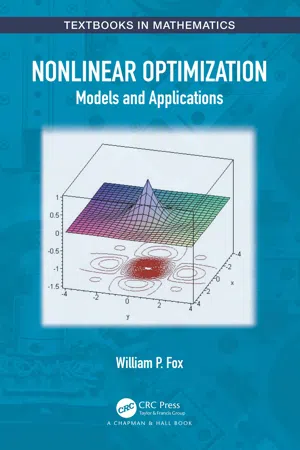
- 280 pages
- English
- ePUB (mobile friendly)
- Available on iOS & Android
About this book
Optimization is the act of obtaining the "best" result under given circumstances. In design, construction, and maintenance of any engineering system, engineers must make technological and managerial decisions to minimize either the effort or cost required or to maximize benefits. There is no single method available for solving all optimization problems efficiently. Several optimization methods have been developed for different types of problems. The optimum-seeking methods are mathematical programming techniques (specifically, nonlinear programming techniques).
Nonlinear Optimization: Models and Applications presents the concepts in several ways to foster understanding. Geometric interpretation: is used to re-enforce the concepts and to foster understanding of the mathematical procedures. The student sees that many problems can be analyzed, and approximate solutions found before analytical solutions techniques are applied. Numerical approximations: early on, the student is exposed to numerical techniques. These numerical procedures are algorithmic and iterative. Worksheets are provided in Excel, MATLAB®, and Maple™ to facilitate the procedure. Algorithms: all algorithms are provided with a step-by-step format. Examples follow the summary to illustrate its use and application.
Nonlinear Optimization: Models and Applications:
-
- Emphasizes process and interpretation throughout
-
- Presents a general classification of optimization problems
-
- Addresses situations that lead to models illustrating many types of optimization problems
-
- Emphasizes model formulations
-
- Addresses a special class of problems that can be solved using only elementary calculus
-
- Emphasizes model solution and model sensitivity analysis
About the author:
William P. Fox is an emeritus professor in the Department of Defense Analysis at the Naval Postgraduate School. He received his Ph.D. at Clemson University and has taught at the United States Military Academy and at Francis Marion University where he was the chair of mathematics. He has written many publications, including over 20 books and over 150 journal articles. Currently, he is an adjunct professor in the Department of Mathematics at the College of William and Mary. He is the emeritus director of both the High School Mathematical Contest in Modeling and the Mathematical Contest in Modeling.
Frequently asked questions
- Essential is ideal for learners and professionals who enjoy exploring a wide range of subjects. Access the Essential Library with 800,000+ trusted titles and best-sellers across business, personal growth, and the humanities. Includes unlimited reading time and Standard Read Aloud voice.
- Complete: Perfect for advanced learners and researchers needing full, unrestricted access. Unlock 1.4M+ books across hundreds of subjects, including academic and specialized titles. The Complete Plan also includes advanced features like Premium Read Aloud and Research Assistant.
Please note we cannot support devices running on iOS 13 and Android 7 or earlier. Learn more about using the app.
Information
Chapter 1
1.1 Introduction
Methods of Operations Research | ||
Mathematical Programming | Stochastic Techniques | Statistical Methods |
Calculus | Decision Theory | Regression Analysis |
Calculus of Variations | Markov Processes | Cluster Analysis |
Linear Progra... |
Table of contents
- Cover
- Half Title
- Series Page
- Title Page
- Copyright Page
- Dedication
- Table of Contents
- Preface: Nonlinear Optimization—Models and Applications
- Acknowledgments
- Author
- 1 Introduction to Optimization Models
- 2 Review of Differential Calculus
- 3 Single-Variable Unconstrained Optimization
- 4 Numerical Search Techniques in Single-Variable Optimization
- 5 Review of Multivariable Differential Calculus
- 6 Models Using Unconstrained Optimization: Maximization and Minimization with Several Variables
- 7 Multivariate Optimization Search Techniques
- 8 Optimization with Equality Constraints
- 9 Inequality Constraints: Necessary/Sufficient Kuhn–Tucker Conditions (KTC)
- 10 Specialized Nonlinear Optimization Methods
- 11 Dynamic Programming
- 12 Data Analysis with Regression Models, Advanced Regression Models, and Machine Learning through Optimization
- Answers to Selected Problems
- Index